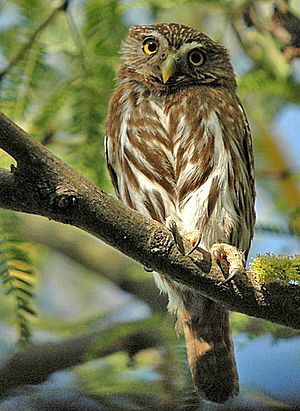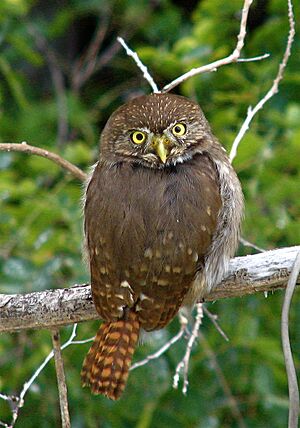Ferruginous pygmy owl facts for kids
Quick facts for kids Ferruginous pygmy owl |
|
|---|---|
 |
|
| Cactus ferruginous pygmy owl | |
| Conservation status | |
| Scientific classification | |
| Genus: |
Glaucidium
|
| Species: |
brasilianum
|
 |
|
The ferruginous pygmy owl (Glaucidium brasilianum) is a small owl found in many parts of the Americas. These tiny owls live in places like south-central Arizona and southern Texas in the United States. Their home range stretches south through Mexico and Central America, all the way into South America. You can find them in countries like Bolivia, Paraguay, and Argentina.
In Central and South America, this owl is one of the most common pygmy owls. It's also one of the most numerous owl species overall in those areas. You can spot them in many different semi-open wooded habitats.
Contents
About the Ferruginous Pygmy Owl
This owl belongs to a large family of owls called Strigidae. These are known as typical owls and include most owl species.
Some special types, or subspecies, of the Glaucidium brasilianum owl live only in certain places. For example, some are found only in Trinidad. Recent studies of their genetics show big differences between owls from different regions. Because of this, the owls from the northern group, called ridgwayi, are sometimes seen as a separate species. They are known as the Ridgway's pygmy-owl (Glaucidium ridgwayi).
What Does This Owl Do?
This owl is mostly active during dawn and dusk. This is called being crepuscular. However, it often hunts during the day too. It eats many different things, including birds, lizards, small mammals, and insects. When it flies, its movement often goes up and down, much like how many woodpeckers fly.
You can often find these owls because small birds will gather around them. These birds will "mob" the owl, meaning they fly around it and make noise to scare it away. Sometimes, up to 40 birds of 11 different species have been seen mobbing just one owl!
Appearance of the Pygmy Owl
The ferruginous pygmy owl is quite small, usually about 15 centimeters (6 inches) long. It has a stocky body with feet and talons that seem very large for its size. Its head has long white or buff streaks. Its wing coverts (the feathers covering the base of the wing) have white spots. The feathers on its belly are heavily streaked with white.
It also has clear white stripes above its eyes, which are part of its facial disc. On the back of its neck, there are two dark spots. Birdwatchers often call these "false eyes." The owl's overall color can change a lot. It can be grey-brown with a black and white striped tail. Or, it can be a rich reddish-brown with a tail that is all one color. Male and female owls look similar, but females are usually a bit bigger and often more reddish.
The Owl's Call
The call of the ferruginous pygmy owl is a clear, whistled hoo-hoo-hoo-hoo. It usually sounds like the musical note E flat. This call is easy to copy. Birdwatchers often use it to attract small birds. These small birds then come to mob the pygmy owl, making it easier for people to spot the owl.
Reproduction and Life Cycle
The mating season for the Glaucidium brasilianum owl starts in late winter and goes into early spring. These owls build their nests in cavities, which are holes in trees or tall cactus plants. The female owl lays between 1 and 7 white eggs. The eggs hatch after about 28 days of incubation. The young owls are ready to leave the nest when they are about 27 to 30 days old.
Different Types of Ferruginous Pygmy Owls
There are many different subspecies of the ferruginous pygmy owl. For example, the G.b.brasilianum subspecies lives in southern Amazonian Brazil, eastern Paraguay, Uruguay, and northeastern Argentina. Another type, G.b.medianum, can be found in the warm lowlands of northern Colombia. The G.b.phaoenloides subspecies lives in tropical northern Venezuela, Trinidad, and the Guianas. Each subspecies has its own specific home range.
Protecting the Ferruginous Pygmy Owl
The northernmost subspecies of this owl is called the cactus ferruginous pygmy owl (G. b. cactorum). This owl was once listed as an Endangered species under the U.S. Endangered Species Act. This law helped protect it in south-central Arizona. The main threats to this owl were losing its habitat and fires caused by buffel grass. Buffel grass catches fire very easily. These fires then spread to cacti, which are the main homes for these owls.
The range of this owl also goes across the border into Sonora, Mexico. Luckily, the Glaucidium brasilianum was removed from the endangered species list in 2006.
See also
 In Spanish: Tecolote bajeño para niños
In Spanish: Tecolote bajeño para niños



